
Psychiatrist Burnout: Tips on Promoting Resilience and Wellness
The prevalence of professional burnout ranges from 25% to 60% among practicing physicians. No wonder then, that the workshop on physician burnout was packed at the APA annual meeting.
Depending on specialty, the prevalence of physician burnout ranges from 25% to 60% among practicing physicians. No wonder then, that the meeting room for the workshop on physician burnout was packed at the APA annual meeting. Under the co-chairmanship of Dr Patricia Ordorica, Drs Christina Kahn and Eva Szigethy presented Bootcamp for Burnout: Strategies to Promote Resilience and Wellness for Psychiatrists. Dr Khan, a fourth-year resident in the Department of Psychiatry and Behavioral Sciences at Stanford University School of Medicine talked about chronic stress and its consequences. Dr Szigethy, Associate Professor of Psychiatry at the University of Pittsburg followed with strategies to reduce stress and avoid burnout-not as difficult as one might think.
Characterized by exhaustion, cynicism, and inefficacy, burnout is a frequent manifestation of chronic stress that affects career satisfaction and patient safety. Work overload, lack of control, insufficient rewards, and breakdown of communication are some of the factors that can lead to burnout. Although depression and anxiety are not symptoms of burnout, they can be its sequelae.
People who are intelligent, caring, and sensitive are at higher risk for burnout, as are those with type A personality traits: competitive, obsessive, compulsive, with a high need for control, who often overextend themselves and are thus chronically late-a description that fits many physicians. It is not surprising then that so many physicians at every level of professional development are prone to burnout: 45% of third-year medical students and 27% to 90% of residents meet established criteria for burnout. The rates differ by specialty and are highest in OB/GYNs (90%). The rate for psychiatric residents is 40%.
Although stress in small doses can be beneficial, the effects of chronic stress and burnout are both physical and psychological and can lead to decreased productivity, lower quality of life, and social isolation. There are 3 levels of burnout: the first is mild and quickly resolves. The second, which is more entrenched and longer lasting, is characterized by waning enthusiasm and idealism, pervasive boredom, loss of interest, and periods of irritation. In the third level, symptoms are chronic and dangerous-the risk of fatal stroke is 89% higher in those who report high levels of stress.
The data regarding the negative effects of burnout are disturbing, but the solution is quite simple. Interventions to promote wellness and reduce the risk of burnout are quick and easy. A few straightforward strategies can go a long way in alleviating stress. These tips:
o Take a look at your schedule and take 1 or 2 items off your daily to-do list
o Take daily time-outs for exercise, yoga, or meditation
o Connect with friends and family in a meaningful way
o Find something to laugh about every day
o Have a mantra that you can turn to when feeling stressed
o Try 4-4-8 breathing: relax and inhale through your nose for a count of 4, hold for a count of 4, and exhale through your mouth for a count of 8
o Try CBT on yourself: relaxation, mindfulness, and life-enhancement techniques can soothe the soul and lessen stress and progression to burnout.
o Finally, good sleep hygiene can also play a role in promoting wellness.
Newsletter
Receive trusted psychiatric news, expert analysis, and clinical insights — subscribe today to support your practice and your patients.

















